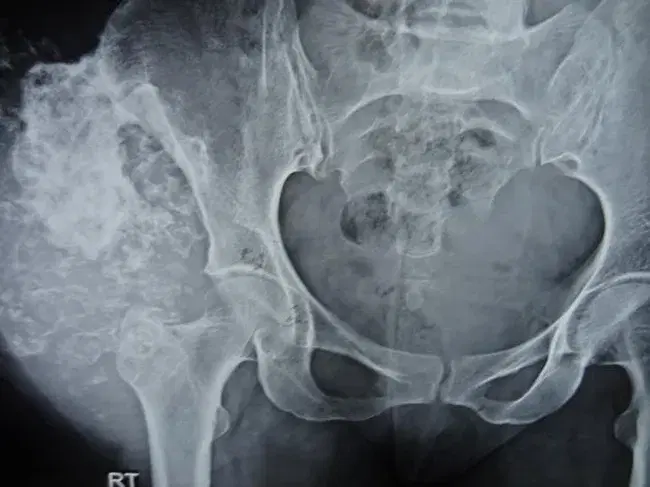
Overview
Chondrosarcoma is a malignant bone tumor that originates in the cartilage-producing cells. It typically occurs in adults over the age of 40 and affects the pelvis, femur, ribs, and shoulder girdle. Unlike many other bone cancers, it is usually resistant to chemotherapy and radiation.
Symptoms
- Deep, dull, and persistent bone pain
- Swelling or a palpable mass
- Limited range of motion if near joints
- Nerve compression symptoms (e.g., tingling or weakness) if the tumor is large
Causes & Risk Factors
- Primary chondrosarcoma (arises de novo)
- Secondary chondrosarcoma (develops from benign tumors like enchondroma or osteochondroma)
- Genetic conditions (e.g., Ollier disease, Maffucci syndrome)
- Age >40 years
Diagnosis
- X-ray (shows lytic or calcified lesions)
- MRI or CT scan (to assess soft tissue and bone involvement)
- Biopsy to confirm histologic grade
- PET-CT or bone scan (for staging)
Treatment Options
- Surgical resection with wide margins (mainstay of treatment)
- Chemotherapy is generally ineffective
- Radiation therapy may be used for inoperable or residual cases
- Targeted therapy in rare subtypes (under investigation)
Prognosis
- Depends on tumor grade and location
- Low-grade: slow-growing with low metastatic potential
- High-grade: more aggressive with worse outcomes
- 5-year survival varies:
- Low-grade: ~90%
- High-grade/metastatic: ~30–50%
Living with this Cancer Type
- Post-surgical rehabilitation
- Regular imaging for recurrence surveillance
- Psychological and mobility support
- Functional adaptations if major bones are affected
Prevention & Screening
- No known preventive strategies
- Genetic counseling for patients with inherited syndromes
FAQs
Q: Is chondrosarcoma common?
A: No, it is a rare type of bone cancer, more common in adults.
Q: Can it be treated without surgery?
A: Surgery is the primary and most effective treatment; other methods are limited.
Q: Does it spread?
A: Yes, especially high-grade tumors, which may spread to lungs or other bones.
Resources
- Bone Cancer Research Trust
- Sarcoma Foundation of America
- ClinicalTrials.gov
Understand Precision Testing
Learn how liquid biopsy and chemo sensitivity testing can personalize your treatment plan.
Make Informed Decisions
Gain knowledge to actively participate in treatment discussions with your healthcare team.
Improve Treatment Outcomes
Discover how precision medicine and metabolic therapies can enhance treatment effectiveness.
Start Your Educational Journey Today
Empower yourself with knowledge about precision metabolic oncology and take an active role in your cancer care journey.
Need More Information?
Our team of oncology experts is here to help you understand your diagnosis and treatment options.
